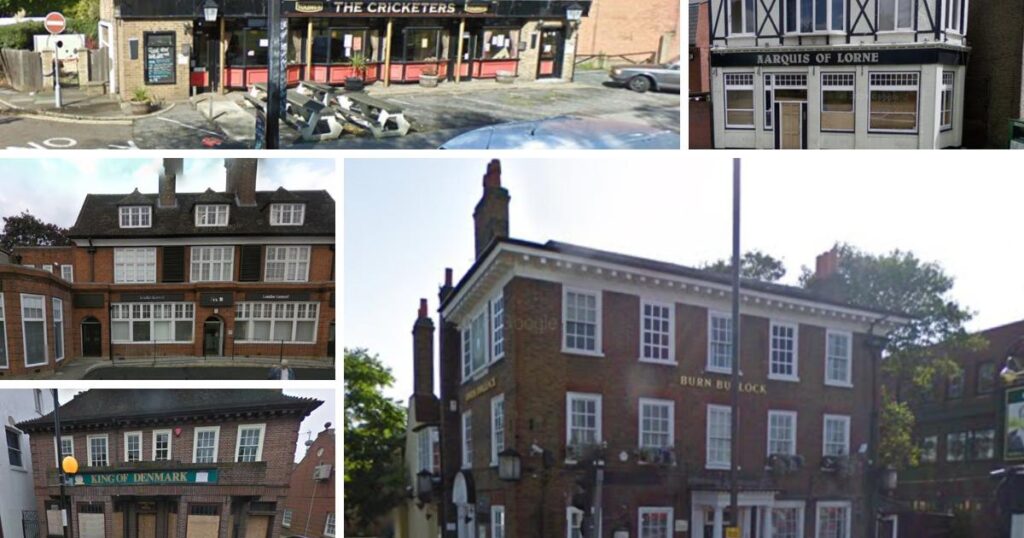Once central to their communities, these pubs were gathering places where locals met to drink, talk and unwind. Now, many exist only in memory.
The decline of traditional pubs is a growing problem across the UK. Last year alone, 412 pubs shut their doors, with London suffering the most closures.
The capital lost 55 pubs, though it still has 3,470 keeping its drinking culture alive. Despite this, many communities have been left without a local.
A new book, London’s Lost Pubs by Sam Cullen (£20, Pen and Sword), explores the history of more than 200 pubs that have disappeared in recent decades.
Sam, whose favourite lost pubs include the Zeitgeist in Lambeth and Sun and Dove in Camberwell, said: “As much as it’s sad that these pubs don’t exist any more, I wanted to make sure they are not lost to time by telling their stories, their history, and some of the quirky characters who drank in them.
“Pubs can tell you so much about social and cultural history. The book is a celebration of pubs that existed as a vehicle for looking at aspects of London life.
“My criteria for inclusion was that they closed within the past twenty-five years, and there was an interesting story to tell.”
Using online reviews, pub guides and local records dating back to the 1920s, Cullen uncovers their stories and the colourful characters who once drank in them.
Sam focused on pubs that have closed in the past 25 years and had interesting histories.
His book keeps the memory of these lost venues alive, ensuring their stories are not forgotten.
Here are some of the most memorable lost pubs from the Merton borough which feature in the new book.
The Burn Bullock
One of Merton’s most significant lost pubs is The Burn Bullock, situated on London Road in Mitcham.
Dating back to the late 16th century, it was originally known as The King’s Arms before being renamed in honour of Burnett “Burn” Bullock, a Surrey cricketer who managed the pub with his wife Lily in the 1950s.
Located next to Mitcham Cricket Club, the pub was a popular meeting point for players and fans alike. However, since its closure in 2013, the Grade II-listed building has fallen into a state of neglect.
Despite developers purchasing the site in 2016 with plans to restore the pub while converting the upper floors into flats, no progress was made.
The building’s condition worsened, and its car park was even used as an illegal scrapyard.
In April 2024, a fire caused significant damage, further casting doubt on its future.
While Merton Council recognises its importance, private ownership has complicated restoration efforts, leaving the building’s fate uncertain.

The Cricketers
Another pub with deep cricketing ties was The Cricketers, also on London Road. Established in 1789, it was initially called The White Swan before becoming a Young’s pub in 1831.
The venue served as headquarters for Mitcham Cricket Club and provided changing rooms for players. During early Ashes tours, the Australian cricket team trained nearby and often visited the pub.
The original building was destroyed in 1940 during the Blitz, and a new pub was constructed in 1957, with legendary Surrey cricketers Eric and Alec Bedser pulling the first pints.
However, in 2009, The Cricketers was sold to developers and demolished the following year.
During clearance, historic photos of local cricketers were found in a skip.
They were rescued by John Strover, a trustee of the Mitcham Cricket Green Community and Heritage Society, and are now preserved in the Merton Memories photographic archive.

The King’s Head
Located on Merton High Street, The King’s Head was one of Wimbledon’s oldest pubs, with some sources dating it back to 1496.
It may have originally served ale brewed by monks at Merton Priory. Young’s Brewery took over in 1831 and rebuilt it in 1934.
In the mid-20th century, it became a lively venue known for musical performances by local bus drivers.
Despite community campaigns by CAMRA and the Sutton Acoustic Music Group, the pub closed in 2004.
Young’s deemed it unviable, and the building was eventually converted into office space for a nearby bus garage.

The King of Denmark
First opening in 1866 on Ridgway in Wimbledon, The King of Denmark was a local favourite.
It gained unexpected royal recognition in the 1960s when the King of Denmark and Princess Marguerite visited, though the reason remains unclear.
It was also a popular stop on actor Oliver Reed’s infamous “Wimbledon Eight” pub crawl.
Despite its charm, the pub closed in 2007. Merton Council initially rejected plans for demolition, but developers won an appeal, and the building was razed in 2011.
A Co-op supermarket now stands on the site.

The Marquis of Lorne
The Marquis of Lorne, on Haydons Road, was a lively Victorian-era pub with a strong East End influence.
Known for raucous singalongs in the 1970s, it was once a popular meeting place for local police officers and detectives from Scotland Yard.
However, by the 2000s, it had gained a reputation for crime, including drug dealing and violence.
In 2007, police in riot gear raided the pub, arresting multiple individuals and seizing weapons such as machetes, an air rifle, and a crossbow.
Reports of underage drinking also surfaced. The pub was subsequently closed and left derelict for over a decade.
In 2019, plans were approved to convert it into flats, with its original façade preserved as part of the redevelopment.





